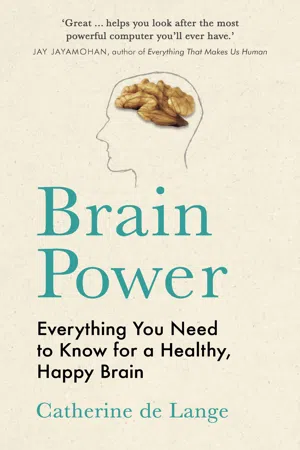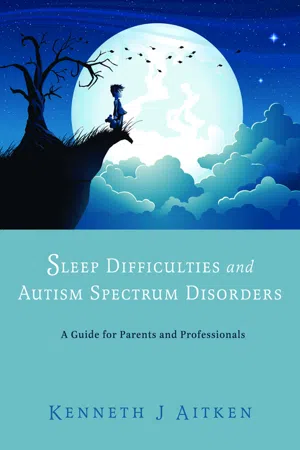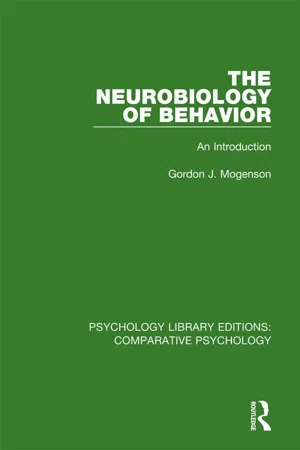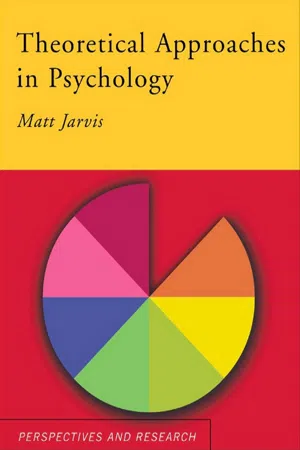Psychology
Brain During Sleep
During sleep, the brain cycles through different stages, including non-rapid eye movement (NREM) and rapid eye movement (REM) sleep. These stages are characterized by distinct patterns of brain activity and serve various functions, such as memory consolidation, emotional processing, and restoration of cognitive function. The brain also undergoes changes in neurotransmitter levels and neural network activity during sleep.
Written by Perlego with AI-assistance
Related key terms
5 Key excerpts on "Brain During Sleep"
- eBook - ePub
Brain Power
Everything You Need to Know for a Healthy, Happy Brain
- Catherine de Lange(Author)
- 2022(Publication Date)
- Michael O'Mara(Publisher)
While we still don’t know exactly why we sleep, what is clear is that the sleeping brain is far from a resting brain. By monitoring what happens inside people’s heads while they slumber using a technique called electroencephalography (EEG), in which small sensors are placed over the scalp, we can see that the brain cycles through different kinds of activity during the night. And one prominent idea is that at least some of this activity is the brain busily sorting through the events of the day, and moving some of our experiences into longer-term memory storage.Before we get on to how to use the memory-boosting effects of sleep to our advantage, we need to understand what happens to the brain in a normal night’s sleep. There are two main types of sleep: rapid eye movement (REM) and non-REM (NREM) sleep. After dropping off at night, we cycle through both of these every ninety minutes or so, and depending on how long you sleep for, you’ll get about four or five of these cycles in a typical night’s sleep.Sleep cyclesREM and NREM sleep are not evenly distributed throughout the night (see the diagram below). In the first part of the night, just after we fall asleep, our brain has a hunger for NREM sleep, which includes deep, restorative slow-wave sleep. As the night progresses, each sleep cycle contains less of this type and more REM sleep, commonly referred to as ‘dream sleep’ or ‘paradoxical sleep’ – because, if you look at the brain during REM sleep, it looks much like it does when we are awake.REM sleep is so called because of the characteristic eye movements people make when in this sleep phase, and it’s also commonly believed to be when we dream. This isn’t entirely true, however – while most of our time in REM sleep is indeed spent dreaming, and those dreams tend to be our most vivid and bizarre, we can also dream in NREM sleep, even if the dreams are a lot more dreary. Another hallmark of REM sleep is that our muscles become inactivated, presumably to stop us acting out our dreams.By comparison, NREM sleep is a lot calmer. Our breathing becomes slower and more regular, and our brain activity slows down. This kind of sleep is thought to be particularly restorative, and when people are sleep deprived, they will have much more NREM sleep when they do nod off again – as if the brain has made it its top priority to catch up on what has been missed. - eBook - ePub
Why We Sleep
Unlocking the Power of Sleep and Dreams
- Matthew Walker(Author)
- 2017(Publication Date)
- Scribner(Publisher)
REM sleep is not the only time during sleep when we dream. Indeed, if you use a liberal definition of dreaming as any mental activity reported upon awakening from sleep, such as “I was thinking about rain,” then you technically dream in all stages of sleep. If I wake you from the deepest stage of NREM sleep, there is a 0 to 20 percent chance you will report some type of bland thought like this. As you are falling asleep or exiting sleep, the dream-like experiences you have tend to be visually or movement based. But dreams as most of us think of them—those hallucinogenic, motoric, emotional, and bizarre experiences with a rich narrative—come from REM sleep, and many sleep researchers limit their definition of true dreaming to that which occurs in REM sleep. As a result, this chapter will mainly focus on REM sleep and the dreams that emerge from this state. We will, however, still explore dreaming at these other moments of sleep, as those dreams, too, offer important insights into the process itself.YOUR BRAIN ON DREAMS
In the 1950s and 1960s, recordings using electrodes placed on the scalp gave scientists a general sense of the type of brainwave activity underpinning REM sleep. But we had to wait until the advent of brain-imaging machines in the early 2000s before we could reconstruct glorious, three-dimensional visualizations of brain activity during REM sleep. It was worth the wait.Among other breakthroughs, the method and the results undermined the postulates of Sigmund Freud and his nonscientific theory of dreams as wish fulfillment, which had dominated psychiatry and psychology for an entire century. There were important virtues of Freud’s theory, and we will discuss them below. But there were deep and systemic flaws that led to a rejection of the theory by modern-day science. Our more informed, neuroscientific view of REM sleep has since given rise to scientifically testable theories of how it is that we dream (e.g., logical/illogical, visual/non-visual, emotional/non-emotional) and what it is that we dream about (e.g., experiences from our recent waking lives/de novo experiences), and even gives the chance to nibble away at surely the most fascinating question in all of sleep science—and arguably science writ large—why - eBook - ePub
Sleep Difficulties and Autism Spectrum Disorders
A Guide for Parents and Professionals
- Kenneth Aitken(Author)
- 2012(Publication Date)
- Jessica Kingsley Publishers(Publisher)
A last view that we need to discuss briefly is that dreams are merely epiphenomena (by-products of some non-mental physiological process needed by the body) – production of growth hormone for physical repair; cortisol for stress reduction or some other such process and that dreams occur as a chance consequence and by-product of this process. This amounts to saying that there is no reason for or mystery behind the purpose or origin of dreams. We just dream because we do.Although it is easy to speculate, and we could probably come up with a number of other possible theories for why dreaming might happen, the nature of sleep and dreaming is inherently subjective and is not open to direct scientific scrutiny. It isn’t possible to get definitive answers to why sleep or dreaming occur.What we do have access to is evidence from measurable physical processes that happen during sleep – changes in our brain activity, metabolism and body biochemistry.WHAT CHANGES OCCUR DURING SLEEP THAT DON’T OCCUR AT OTHER TIMES?Understanding the workings of the brain has taken many paths: in recent years these have been dictated more by the tools available, while in the past the restrictions have been more to do with religious prescription. The two major developments in our understanding to date have come from studying the electrical patterns of activity in the brain and from the growing understanding of its chemistry. An excellent overview of these apparently competing models and how they developed can be found in Elliot Valenstein’s book The War of the Soup and the Sparks – the Discovery of Neurotransmitters and the Dispute over How Nerves Communicate (2005).The stages of sleepWhen we sleep, we are said to go through four ‘sleep stages’ (stages 1 through stage 3 sleep, and REM sleep). These stages typically occur in a specific sequence. The idea of distinct sleep stages was first proposed in 1937, based on observed EEG differences (Loomis, Harvey and Hobart 1937). The first agreed classification was formalized in 1968 (Rechtschaffen and Kales 1968). The classification was revised most recently in 2007 (Iber et al. 2007) when a distinction between what had previously been called stage 3 and stage 4 sleep was dropped.Each sleep stage has characteristic neurophysiological features with associated behaviours. Interpretation of the EEG profile is a highly skilled procedure, because sleep and arousal change with the age of the person (see Grigg-Damberger et al. 2007). Changes in non-REM slow-wave electrical activity are associated with the stage of structural maturation and synaptic development the brain has reached (Tononi and Cirelli 2006). These developmental differences are being used in studying the pattern of cortical development through childhood and adolescence (Kurth et al. - eBook - ePub
The Neurobiology of Behavior
An Introduction
- Gordon J. Mogenson(Author)
- 2018(Publication Date)
- Routledge(Publisher)
Mental activity of a cognitive rather than an emotional nature may also influence sleep. The student who studies right up to the time of going to bed may not sleep very readily and for that matter neither may the professor who works late on his lecture to be delivered to the student’s class the next morning. Problem solving, thinking, and cognitive activities, especially when associated with worry, anxiety, or emotional problems, may lead to “tossing and turning” in bed rather than a good night’s sleep.THE NEURAL SUBSTRATES OF SLEEP AND WAKINGIn considering the neural mechanisms of sleep and waking, we depart somewhat from the approach of the other chapters. Instead of dealing in turn with each of the factors that contribute to the various motivated behaviors, we take an historical approach and begin with the view that dominated the field for a number of years—a view that emphasized the importance of external stimuli for wakefulness and that regarded sleep as a passive process.Two major recent developments are then considered. The first is experiments that led to the hypothesis that sleep is an active process, a reversal of the earlier view. The second is the demonstration that there are two kinds of sleep (slow- and fast-wave sleep) and the attempt to associate the two kinds of sleep to the recently demonstrated chemical neuroanatomical pathways projecting from the midbrain and brainstem to forebrain structures.Sleep as a Passive ProcessThe modem era of investigating the neural basis of sleep began about 40 years ago shortly after the discovery of the electroencephalogram (Berger, 1929) and the subsequent demonstration of a relationship between brain-wave patterns and level of consciousness (see Figure 7.2 ). Important pioneering studies were carried out by Bremer (1937), who concluded that sleep was a passive process. Another pioneer investigator of the physiology of sleep, Nathaniel Kleitman (1939), also considered sleep a passive phenomenon; in his words, sleep is the “cessation of an active condition of wakefulness [p. 502].”5 - eBook - ePub
- Matt Jarvis(Author)
- 2005(Publication Date)
- Routledge(Publisher)
9 Biological psychology 2: neurophysiology
Key assumptions of the approach The brain Techniques for measuring brain function Bodily rhythms and sleep Theories of sleep Dreams Key application: understanding the effects of shiftwork and jet lag Contemporary issue: are gender differences due to biological factors? Contributions and limitations of biological approaches SummaryKey assumptions of the approach
If you have studied biology, you may by now be asking some very reasonable questions about the relationship between biology and psychology. Surely there must be biological influences on psychology, yet rather surprisingly it is quite possible to read most of a psychology textbook like this without a mention of the humble brain. Regardless of other factors, all thinking, feeling and behaviour is ultimately dependent on the brain and the rest of the nervous system. In this chapter we shall look very briefly at the structure and function of the brain, and at some of the techniques we use to study it. We can then look in depth at bodily rhythms, sleep and dreams, and examine a key application of this field—understanding the effects of shiftwork and jet lag. We can then have a look at a contemporary issue in psychology: whether differences in the abilities and characteristics of men and women can be explained by biological differences. First, however, let us look at the assumptions that underlie the neurophysiological approach to psychology:
Learn about this page
Index pages curate the most relevant extracts from our library of academic textbooks. They’ve been created using an in-house natural language model (NLM), each adding context and meaning to key research topics.




